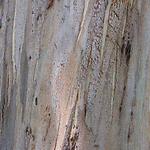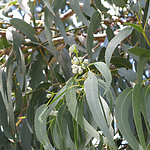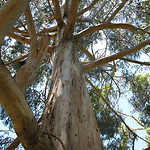Person
Blakely, William Faris (1875 - 1941)

Eucalyptus globulus subsp.bicostata (Maiden, Blakely & Simmonds) J.B.Kirkp (1974), Southern Blue Gum, detail of bark, 23 January 2013
Details
- Born
- November 1875
Tenterfield, New South Wales, Australia - Died
- 1 September 1941
Hornsby, New South Wales, Australia - Occupation
- Botanical collector, Botanist and Gardener
Summary
William Blakely was a gardener and a botanist with a special interest in eucalypts. J.H. Maiden recruited him to the Royal Botanic Gardens in Sydney, where he worked as a gardener from 1900-1913. He was transferred to the National Herbarium where he worked as a botanist from 1913-1940. In 1934 he published A Key to the eucalypts, of which posthumous editions were published in 1955 and 1965. With this work, Blakely devised an entirely new classificatory system for the eucalypts which is to a large part the basis of modern infrageneric classification of the genus. He described hundreds of species. Joseph Maiden honoured him in 1917 with Eucalyptus blakelyi Maiden.
Details
Chronology
- 1898 - 1900
- Career position - Worked at the Henolan Caves in the Blue Mountains, near Sydney
- 1900 - 1913
- Career position - Worked at the Sydney Botanic Gardens
- 1913 - 1940
- Career position - Worked at the Sydney Herbarium, starting as a botanical assistant
- 1917
- Taxonomy event - Eucalyptus blakelyi Maiden was named in his honour.
- 1924
- Career event - Elected Associate Member (Botany), Australian National Research Council
- 1927
- Taxonomy event - Eucalyptus globulus subsp.bicostata Maiden, Blakely & Simmonds
- 1940
- Career event - Retired from the Sydney Herbarium
- 1940 - 1941
- Career position - Honorary custodian of the Eucalyptus collection at the Sydney Herbarium
Related entries
Archival resources
Adolph Basser Library, Australian Academy of Science
Published resources
Encyclopedia of Australian Science and Innovation Exhibitions
- McCarthy, Gavan; Smith, Ailie; Moje, Christine; Rigby, Rebecca, The Study of Australian Eucalypts, eScholarship Research Centre, 2013, http://www.eoas.info/eucalypts/index.html. Details
Books
- Blakely, W. F., A Key to the Eucalypts with descriptions of 500 species and 138 varieties and a companion to J. H. Maiden's Critical Revision of the genus Eucalyptus (Sydney: Government Printer, 1934). Details
- Blakely, W. F., A Key to the Eucalypts with descriptions of 522 species and 150 varieties (Canberra: Commonwealth Forestry and Timber Bureau, 1955). Details
- Blakely, William Faris; Rodger, G.J., Supplement to A key to the eucalypts (Blakely, 1934) : covering species described, and changes in nomenclature, since 1934 (Canberra: Forestry and Timber Bureau, 1953), 26 pp. Details
- Maiden, J. H., A critical revision of the genus Eucalyptus, 8 vols (Sydney: Government Printer, 1903 - 1933). Details
- Simmonds, Joseph Henry, Trees from other lands for shelter and timber in New Zealand: eucalypts (Auckland, New Zealand: Brett Publishing, 1927), 164 pp. Details
Journal Articles
- Blakely, W. F., 'Descriptions of nine new species of Eucalyptus', Journal and Proceedings of The Royal Society of New South Wales, 61 (1927), 149-178. http://handle.slv.vic.gov.au/10381/113499. Details
- Blakely, W. F., 'Description of 3 new species and 1 variety of eucalyptus of the Elder & Horn expedition', Proceedings of the Royal Society of South Australia, 60 (1936), 153-156. Details
- Blakely, W. F.; McKie, E. N.; and Steedman, H., 'Descriptions of 4 new species and two varieties of eucalyptus', Proceedings of the Linnean Society of New South Wales, 63 (1938), 65-69. Details
- Kirkpatrick, J.B., 'The numerical intraspecific taxonomy of Eucalyptus globulus Labill. (Myrtaceae)', Botanical Journal of the Linnean Society, 69 (2) (1974), 89-104. Details
Resources
- Wikidata, http://www.wikidata.org/entity/Q8005619. Details
- VIAF - Virtual International Authority File, OCLC, https://viaf.org/viaf/94029453. Details
- ' Blakely, William Faris (1875-1941)', JSTOR Global Plants, JSTOR, 2013, http://plants.jstor.org/person/bm000391205. Details
- 'Blakely, William Faris (18751101-19410901)', Trove, National Library of Australia, 2009, https://nla.gov.au/nla.party-595564. Details
See also
- 'See the list of eucalypts published under this authority using abbreviation search % Blakely % (include wildcards) and family 'Myrtaceae'', Australian Plant Name Index (APNI), Australian National Botanic Gardens, 2012, http://www.anbg.gov.au/cgi-bin/apni. Details
- Hall, Norman, Botanists of the Eucalypts: short biographies of people who have named eucalypts, whose names have been given to species or who have collected type material (Melbourne: CSIRO, 1978), 101 pp. Details
- Sheppard, H. et al., Eucalypts, Australian Government, 2007, http://australia.gov.au/about-australia/australian-story/eucalypts. Details
Digital resources

- Title
- Eucalyptus globulus subsp.bicostata (Maiden, Blakely & Simmonds) J.B.Kirkp (1974), Southern Blue Gum, detail of bark
- Type
- Image
- Date
- 23 January 2013
- Place
- Royal Botanic Gardens Melbourne

- Title
- Eucalyptus globulus subsp.bicostata (Maiden, Blakely & Simmonds) J.B.Kirkp (1974), Southern Blue Gum, detail of leaves
- Type
- Image
- Date
- 23 January 2013
- Place
- Royal Botanic Gardens Melbourne
Ailie Smith, Neville Walsh and Christine Moje
Created: 26 April 2012, Last modified: 30 April 2024
- Foundation and Current Supporter - Bjarne K Dahl Trust

